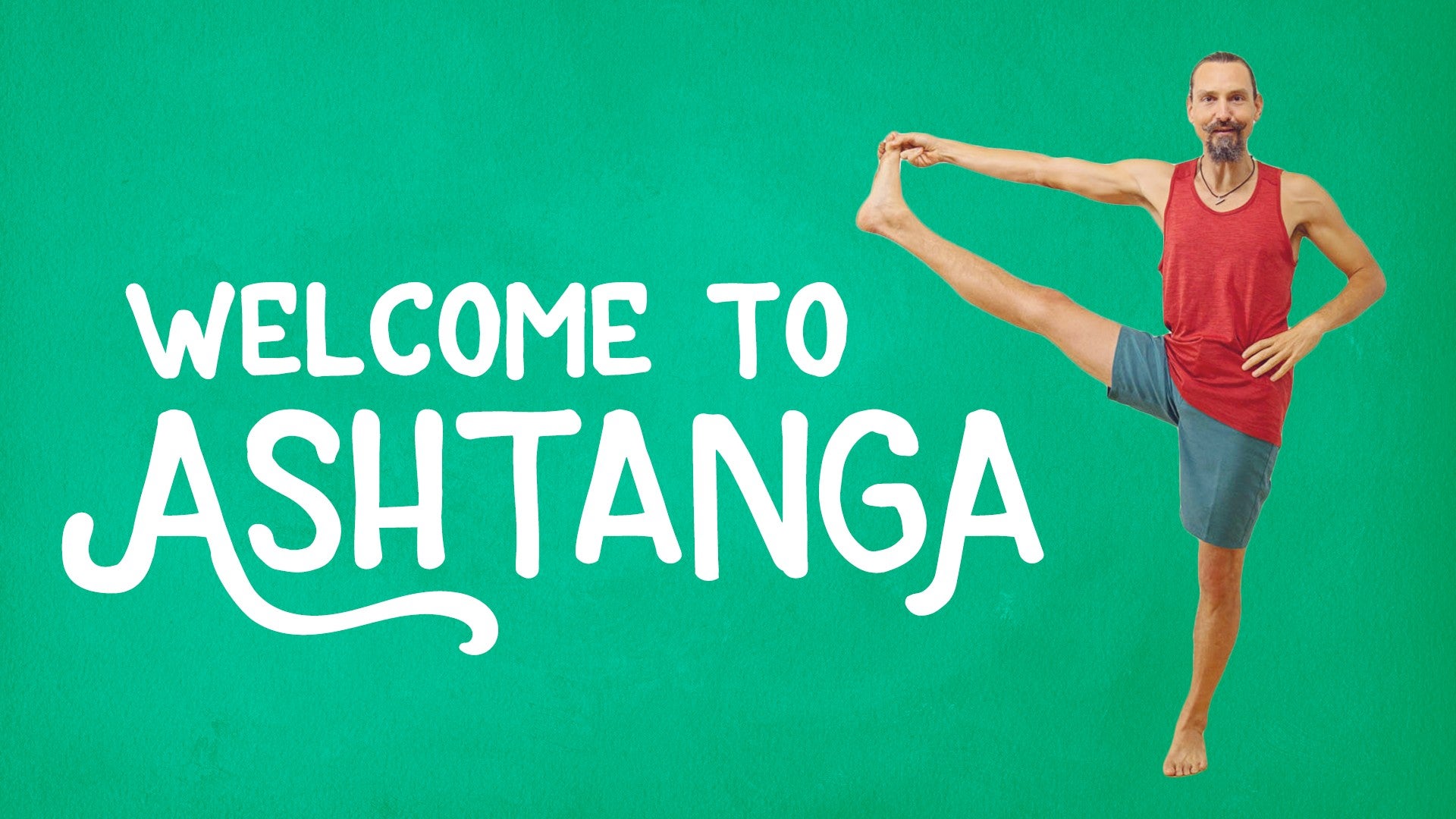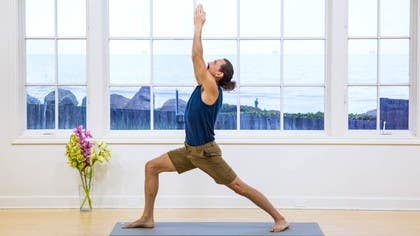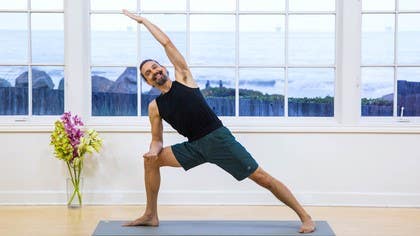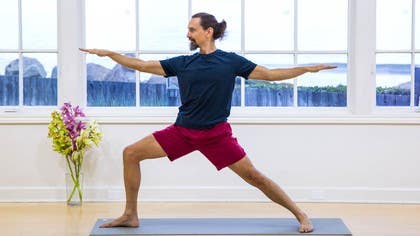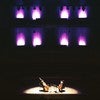Description
About This Video
Transcript
Read Full Transcript
Welcome to a fresh new day with sun salutations A and B. Whether you're new to the Ashtanga or yoga practice, or whether you're restarting a practice, or just looking for a really short form, these sun salutations contain the essence of the entirety of the Ashtanga practice. So it's sort of like everything you need to know you could learn in sun salutations. Let's begin standing at the top of your mat in Samastitihi. Ekam, inhale, allowing the breath to open the chest, allowing the shoulders to roll back and the arms to float up in response. Dway, exhale, folding forward, letting the belly move towards the spine and create that downward flow. You can bend the knees on the first few if you like, reaching down and dropping the head. Trini, inhale, the head looking forward, the chest opening, the collarbones broaden with breath. And then Chaturwadi, exhaling as you step back and lower down into any modified Chaturanga, you could drop onto your knees and then even come all the way down on your belly on the mat.
Pancha, inhaling, allowing the breath to lift the chest through the shoulders, roll back and down in a baby cobra or upward dog. Shot, exhaling, letting the belly again dive towards the spine to lift the hips in downward dog. And your first one or few downward dogs, you may want to keep the knees bent, one, as you breathe deeply and comfortably here. Two, allowing the spine to be in line with the arms. Three, and feeling like you're lifting the hips towards the back corner of the room. Four, take one full inhalation, one full exhalation. Five, and then it's up to inhaling, stepping or jumping the feet forward, looking forward with the head up, spine long. Ashtau, exhale, again fold forward, let the head dangle and drop as you reach forward towards the mat. Nava, inhale, rising all the way up, measuring the breath, feeling the collarbones broaden, the arms lift, and exhaling right back to that neutral and engaged Samastitihi.
The end of the exhalation may find the pelvis weighty as the tailbone points down and Udi and Abunda draws the low belly in, keeping the pelvis stable and still. The second one, Ekam, inhale, the arms up, see your thumbs meet. Dwe exhale, making sure to complete the exhalation by pushing out extra breath. Trini, inhale, keeping the belly scooped as the spine lengthens, looking forward. Chaturi, exhaling, stepping or jumping and lowering down to any Chaturanga variation, keeping the tailbone pointing towards the heels, keeping the belly strong as you punch. Inhale, let the chest lift through the shoulders and shot, exhale to downward facing dog. Taking long, slow, full deep breaths here. One, if it's comfortable for you and you can keep the spine long, then you can start to straighten the knees too and drop the heels towards the mat.
Three, it's fine if your heels are still uplifting off the mat, that's fine, just keep breathing. Four, and if the heels touch, absolutely fine as well as you spread the toes, spread the fingers. Five, sapta, inhaling, stepping or jumping the feet forward, scooping the belly as you look forward. Ashta, exhale, completely as you fold, drawing the belly to the spine. And nava, inhale, keep the tailbone pointing down towards the heels, anchoring the pelvis as the arms lift, see thumbs, exhaling right back to samastitihi.
Watching where your eyes go, Ekam, inhale, see your thumbs, Dway, exhale, folding forward, letting the eyes dive towards the nose or looking down the cheeks. Trini, inhale, the breath shaping the drishti as you look forward. And Chaturwadi, exhale, stepping or jumping and lowering down to any chaturanga, chin is forward, drishti, nose. Pancha, inhale, maybe you can keep the eyes focused on the nose and upward dog. Shat, exhale, lifting the hips in downward dog and letting the eyes settle onto a comfortable resting place, one, on your body.
So maybe you can look down your nose, two, that may feel like it's crossing the eyes and uncomfortable, in which case you could look on your knee or on your leg somewhere. Three, you may be able to tuck the chin deeply enough to look towards your navel. Four, but don't lose that length through the upper spine, keeping the spine in line with the arms. Five, it's up to inhaling, stepping or jumping forward, the head up, the spine long, look forward. And ashta, exhale, give in to that forward fold, whether the hands are touching the mat and grounding completely or just on the legs, drop the head, look down your nose.
Nava, inhale, rising all the way up, stretching the breath long, see your thumbs. Exhale, right back to that neutral posture of samastitihi, the shoulders rolling back and down so that the collarbones are really broad. Ekam, inhale, keeping the collarbones broad and the shoulders rolled back and down, see your thumbs. Dway, exhale, folding forward, drop the head. Trini, inhale, still rolling the shoulders back and down as you look forward.
Chaturadi, exhaling into chaturanga with the broad collarbone experience. Pancha, inhale, let the chest rise forward through the shoulders as they roll back and down, the elbows stay slightly bent. Shat, exhale, downward facing dog. In downward dog as well, trying to let the outside upper arm roll forward towards the face, one, so that your shoulders feel released and relaxed away from the ears. Two, keeping that broad collarbone experience so the breath rises to the top of the chest.
Three, still with the eyes resting on a drishti and every exhalation strengthening the lower belly. Four, maybe always finding mula bandha, the root lock as well. Five, sapta, inhale, step or jump forward, the head lifts and the shoulders remember to roll back and down. Ashta, exhale, folding forward, dropping the head, seeing the nose. Nava, inhale, rising all the way up, keeping the shoulders away from the ears, see thumbs. Exhale, samastitihin.
And your last one, simply hearing the sound of that whispering breath at the back of the throat. Ahekam, inhale, arms up. Dway, exhale, fold forward. Trini, inhale, chest lifts, shoulders back, look forward. Chatwari, exhale. Chaturanga. Pancha, inhale, upward facing dog. Chatwari, exhale, downward facing dog.
One. Two, letting the head feel relaxed as it hangs. Three, keeping the jaw soft so the back of the throat can measure the breath. Four, letting that sound of breath draw your awareness internally. Five, sapta, inhale, stepping or jumping forward, head up.
Ashta, exhale and fold. Nava, inhale, rising all the way up, see your thumbs meet. Exhaling, samastitihin. Sun salutation B. Ahekam, inhale, bending the knees, dropping the weighty anchor of the pelvis down towards the heels and rising the arms up, see the thumbs meet. Dway, exhale, folding forward. Again, the hands may only touch the legs or may touch the mat or you may be grounding the palms completely. Trini, inhale, head up, look forward.
Chatwari, begin the exhale here and during the exhalation, step or jump to any chaturanga that serves you at the moment. Pancha, inhale, flattening the toenails on the mat, baby cobra or upward dog, always an option. Chat, exhale, downward facing dog, lifting the hips to the back corner of the room and sapta with your next inhalation, pivot on your left root knuckle, the big toe mount. Ground the left heel and pushing off the left heel, lift the hips, draw the right knee up towards the right shoulder and see how far you can get the right foot forward. It may not come next to the hand, that's okay, it might be behind the hand and that's alright.
With your next inhalation, drawing the arms up, keeping the right knee deeply bent, see the thumbs meet together, still shoulders are down. And then ashta, exhale, fold forward, put the hands back where they were. So if you didn't get the foot next to the hand, the hands go right back to the front of the mat in front of the foot. And you may be taking an extra inhalation here as you pivot on the left big toe mount, drawing the heel up off the mat. And with your next exhale, stepping the right foot back, lowering down into any chaturanga, nava inhale, collarbones broad, chest up through the shoulders, upward facing dog, dasa exhale, downward facing dog.
Finish the exhalation there. Ekadasha, with the inhale, pivot on the right big toe mount, step the right heel deeply onto the mat, still inhaling or your next inhale, draw the left knee forward, the left foot forward. You may need an extra exhalation here. And with the next inhale, rise up, broaden the collarbones, see the thumbs meet. And then Dwadasa, exhale, the hands right back to where they were, the left foot back, right back to where it was, and you're in chaturanga.
Trayogdasa, inhale, upward facing dog. Tratogdasa, exhale, downward facing dog. And breathe here. Every exhalation, a great chance, one, for you to refine and refine udiyana bandha. Two, the head dangling, the eyes settling into a very still place, the drishti.
Three, could be on your nose, your navel or your knee. Four. Five, pancharsha, inhaling, step or jump the feet forward, the head up. Shorsha, exhale, fold forward, drop the head. And saptarsha, inhale, bend your knees, squeezing knees together, the pelvis weighty and anchoring as the arms lift.
Exhale, samastitihi. So you're always welcome to take extra breath as you need or approach it on a more refined pace, stretching the breath long. Exhale completely. Ekam, inhale, bend the knees, arms lift. Dway, exhale, fold forward, drop the head.
Trini, inhale, head up, look forward. Chaturadi, exhale, step or jump, anicchaturanga variation, panchah, inhale, upward facing dog. Shaat, exhale, downward facing dog. Sapta, inhale, the right foot forward, the heels in one line. And as the arms lift, the shoulders roll back and down.
Ashta, exhale, right back to anicchaturanga variation. Nava, inhale, upward facing dog, anicchaturanga variation. Dasha, exhale, downward facing dog. Ekarasha, inhale, step the left foot forward, heel in line with the right heel grounding. Arms up, shoulders down, sea thumbs.
Dwarasha, exhale, chaturanga dandasana. Triyog, dasha, inhale, upward facing. Triyog, dasha, exhale, downward facing dog. One, still reminding the upper arms to roll forward towards the face. Two, so that you get space between the ear and shoulder.
Three, all the while spreading the fingers, the thumbs really pulled back. Four, and grounding through the index mound of the hand, the root knuckle grounding. Five, pancharsha, inhale, step or jump forward. Spine lengthens, head up. Shodhasha, exhale and fold forward, drop the head.
Saptarsha, inhale, bend your knees, swing up your hands, see thumbs. Exhale, samastitihi. Ekam, inhale, arms up, knees bend. Dway, exhale, fold forward, drop the head. Trini, inhale, head up, look forward. Chatwari, exhale, jump back, chaturanga, pancha, inhale, upward facing dog.
Shodh, exhale, downward facing dog. Sapta, inhale, right foot forward, knee deeply bent, arms float up, see thumbs. Ashta, exhale to chaturanga dandasana. Nava, inhale, upward facing dog. Dasha, exhale, downward facing dog.
Ekadasha, inhale, left foot forward, arms up. Dwadasha, exhale, chaturanga. Triyugdasha, inhale. Chaturgdasha, exhale, downward facing dog. Keep breathing.
One, measuring the air at the back of the throat. Two, that practice will have many benefits on many levels. Three, it will draw the awareness internally as you hear the sound of breath. Four, and measuring the breath will also allow you more time to transition mindfully between the postures. Five, panchadasha, inhaling, step or jump forward, head up.
Chodh, exhale and fold. Saptadasha, inhale, bend your knees, swing up the arms with the knees bent. Exhale, stand tall through straight legs into samastitihi. Just listening to the count and listening to your own breath. Ek, and inhale. Dway, exhale, see if you can remember the flow of postures and physical alignments.
Trini, inhale. Chaturgdi, exhale, so that you can practice on your own. Pancha, inhale. Shat, exhale. Sapta, inhale, right foot.
Ashta, exhale. Chaturanga. Navain, here. Dasha, exhale. Ekadasha, inhale, left foot.
Dwar, sha, exhale, chaturanga. Trayub, sha, inhale. Chaturgdi, sha, exhale. One, at first downward dog might feel like a challenging position. Two, but with repeated practice and time, it will become like a home base.
Three, a place for you to re-center your awareness. Four, to refine your breath and your bandhas. Five, panjarsha, inhale, head up. Shorsha, exhale, fold forward, drop the head. Saptarasha, inhale, bend your knees, then lift the arms.
Exhale, samastitihi. And we'll do one more, sun salutation B, together. Ekam, inhale, bending the knees, the weighty pelvis drops, the arms lift, see thumbs. Dway, exhale, fold forward, drop the head. Vini, inhale, long spine, head up.
Chaturadi, exhaling, and during the exhale, finding your way to any chaturanga variation. Pancha, inhale, chest forward, the broad collarbones, elbows micro bent. Shat, exhale, downward facing dog. Sapta, inhale, pivot on the left foot, step the right foot forward, draw the arms up. Arshta, exhale, to chaturanga dandasana.
Nava, inhale, chest forward, shoulders back, elbows micro bent. Dasha, exhale, downward facing dog. Ekarasha, inhale, pivot on the right foot, step the left foot forward, raise the arms up. Dvarsha, exhale, chaturanga dandasana, taking as many breaths as you need to get there. Yogdasha, inhale, upward facing.
Chaturagdasha, exhale, downward facing dog. One. Two, measuring the air at the back of the throat. Three, and hearing that whispering sound of your own breath. Four, it guides you forward and deeper into the practice.
Five, panjarsha, inhale, step or jump feet forward, head up. Shorsha, exhale, folding forward, drop the head. Saptarsha, inhale, bending your knees, squeezing knees together, see the thumbs meet together. Exhale, straight, strong legs, drawing back to your center in samastitihi, and take a few breaths here. Feeling any change that's come about from doing 5 Surya Namaskara A, 5 Surya Namaskara B, every exhalation, grounding through the Bandhas, every inhalation, drawing breath upwards, measuring the air at the back of the throat.
So you may be using these sun salutations to begin your day's practice. You may continue forward through standing and seated, back bending asanas or finishing asanas, or perhaps for whatever reason today, that's your complete practice. And again, that's a wonderfully complete practice. It's like the entire practice in a short form. You've got the essence of everything that matters there.
I encourage you to keep practicing, keep looking inside, and hopefully be in touch with any questions. Thank you.
Welcome to Ashtanga
Comments
Dear Dylan! Your
calming yet energizing voice cuing Surya Namaskar A and B, which I agree
contain the essence, makes this a wonderful practice. Thank you!
You need to be a subscriber to post a comment.
Please Log In or Create an Account to start your free trial.
